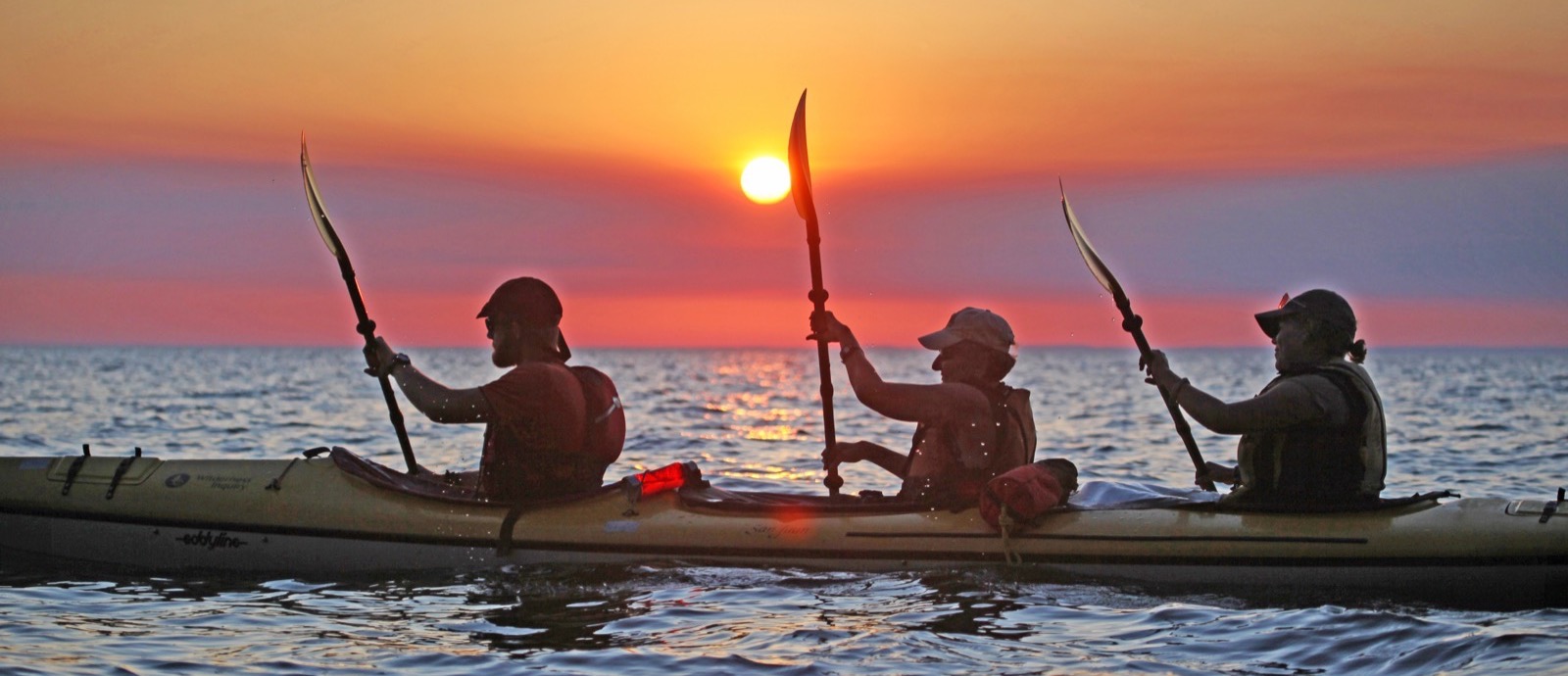Overview
Located on the South Shore of Lake Superior, the Apostle Islands are known for sea caves, sandy beaches, historic lighthouses, and sunken shipwrecks. After a day of preparation at Base Camp, your next four days will be spent kayaking and camping among the inner ring of islands. Your route may take you to the turn-of-the-century Raspberry Island lighthouse or the Swallow Point Sea Caves of Sand Island, where twisted sandstone pillars have been sculpted by millennia of wave action. Whatever your route, the scenery is stunning and the possibilities are endless on this adventure!
Sample Itinerary
Expand All FieldsDay 1: Arrive at Wilderness Inquiry's beautiful Little Sand Bay Base Camp and partake in sea kayak orientation.
Arrive at Wilderness Inquiry's Little Sand Bay Base Camp in the early afternoon. Upon arrival, review personal gear and prepare for your trip to the islands. Participate in a sea kayak orientation and get your first view of Lake Superior. Spend one night at our beautiful base camp before heading out to the islands.
Day 2: Paddle past the sunken shipwrecks of Buffalo Bay to Oak Island.
Get up early for breakfast and great coffee. Pack up camp and launch from Red Cliff Bay. Paddle out into Lake Superior past the incredible sunken shipwrecks of Buffalo Bay. Cross to Oak Island and settle in at a campsite on a grassy knoll overlooking Lake Superior.
Day 3: Explore Oak Island on foot or paddle to nearby Raspberry Island.
Explore the shoreline and trails of Oak Island. Circumnavigate the rocky and beautiful shores by foot or take a side paddle to a historic lighthouse on Raspberry Island. Enjoy dinner and a breathtaking sunset over Lake Superior. Camp a second night on Oak Island among the beautiful hemlock and pine trees.
Day 4: Hike the beautiful trails of Basswood Island and spend an afternoon relaxing on sandy beaches.
Pack up camp and island hop to Basswood, home for the last night. Hike the beautiful island trails to an old brownstone quarry and relax at the sandy beaches. Enjoy one last dinner on the remote islands, recounting the adventures had around the campfire.
Day 5: Enjoy one final paddle back to base camp before saying farewell to your trip mates.
Break camp and enjoy one more morning on the water as you paddle back to mainland. Return to base camp to unpack, clean-up, and say goodbye to new friends.
What to Expect
TYPE OF TRAVEL/DISTANCE: You will travel in tandem sea kayaks, which hold 2 or 3 people plus all necessary gear. An average day’s travel consists of 2-6 paddling hours, depending on weather conditions.
Read more »Frequently Asked Questions:
Where do we meet?
Standard Meeting Places and Times
Start: Little Sand Bay Base Camp at 1:30 PM (local time)
End: Little Sand Bay Base Camp at 1:30 PM (local time)
Transportation
This trip begins at 1:30 PM at our Little Sand Bay Base Camp near Bayfield, WI, where parking is available. This trip ends at Little Sand Bay Base Camp at 1:30 PM. Detailed meeting place directions will be sent to you when you are confirmed for the trip. Booking a flight? We recommend flying in the night before your trip to Duluth or Minneapolis St. Paul airports, and flying out from Duluth after 5:30 PM and from Minneapolis St. Paul after 9:00 PM.
Can I go kayak camping on the islands if I have a disability?
Most likely, yes, but since each person is unique, we'll ask you to complete a standard health assessment when you register. We recommend that you go ahead and register, and we will call you to discuss any issues or concerns.
Do I need paddling experience to join a canoe or kayak trip?
Paddling trips with WI are appropriate for beginners and seasoned paddlers alike. On the first day of all trips, basic paddling strokes will be taught by the trip leader. Each trip gives participants multiple opportunities to practice their skills. Participants with more experience will have plenty of opportunity to paddle during the trip, and even to help teach less experienced paddlers!
What is the base camp like on the Apostle Islands trips?
We refer to our property as the Little Sand Bay Base Camp. The camp is approximately 1,500 feet from the Lake Superior lakeshore near Little Sand Bay in Northern Wisconsin. Our base camp offers camping at its most comfortable and accessible. All tents are large enough to stand upright, and are set up on comfortable wooden platforms. Hot showers, private bathrooms, a roofed pavilion space, and an indoor seating area for leisure time are other key features. The camp consists of 40 acres of woods with wood chip trails, 5 campsites, and a gear warehouse. Watch this short video to see what it is like.

